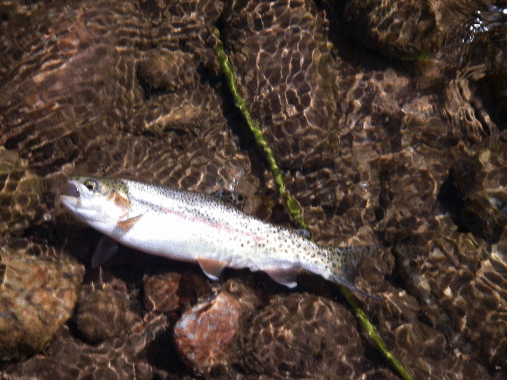 Our local rainbows
are very brightly colored despite this photo indicating this one as more on the
silver side.
Our local rainbows
are very brightly colored despite this photo indicating this one as more on the
silver side.August, 2006
8/2: Maybe it's appropriate to start the last month of the summer by making my first outing of the year on our "home" stream of Gore Creek. Seems impossible that it's taken this long to start wading that beautiful little creek, portions of which are only 100 steps from the door of the condo, but it's just the case this year.
Due to an ongoing series of strong thunderstorms passing through Colorado, Sue & I opted to not make the three hour drive to the White River. She worked at her office today, and I did some of the same this morning at mine, and then I hopped on my bike and peddled out towards the eastern part of town along the creek flowing by the freeway. After running high and murky late yesterday afternoon, the flows have cleared and settled down and the stream was in fine shape.
Actually the creek is probably already a bit on the low side of a perfect flow rate, but it's easy wading now and certainly not too cold. Rigged up slightly differently today with a #18 gray bodied WRS up front and a similar sized red copper john as the trailing nymph.
Both seemed to do the job, although though the dry was probably a bit more popular.
 Our local rainbows
are very brightly colored despite this photo indicating this one as more on the
silver side.
Our local rainbows
are very brightly colored despite this photo indicating this one as more on the
silver side.
I'd forgotten how much fun it is to fish this little brook flowing at maybe 30 cubes right now.
The fish were concentrated in the deeper runs, riffles and holes behind structure that was artificially created maybe twenty years ago.
Even with gusty west winds causing the fly to end up in the willows from time to time, casting was pleasant and easy.
Suspect I worked roughly a mile of the creek. Every place that should have held fish did so.
The better sized ones - as should be expected - were much quicker to inspect and reject the surface fly. 7X tippet might have been a better choice this afternoon.
Results were much as one might expect on waters of this size. Most of the fish released were rainbows in the six to twelve inch range. A handful of browns of similar sizes had the same (nice) fate.
The photo below of a head out of the water was a very nice thirteen inch Colorado cutthroat.
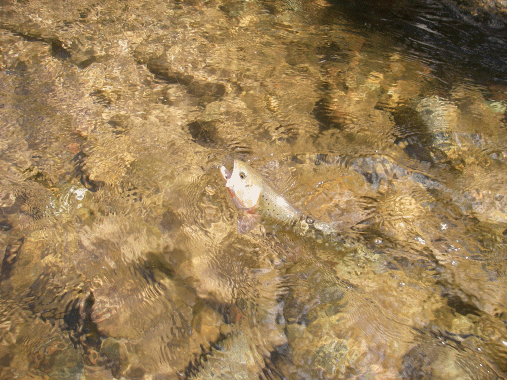
Only thing missing from achieving a local grand slam was a brookie.
My ineptness at setting the hook on some larger fish meant those fourteen to sixteen inchers have earned their right to grow to those sizes.
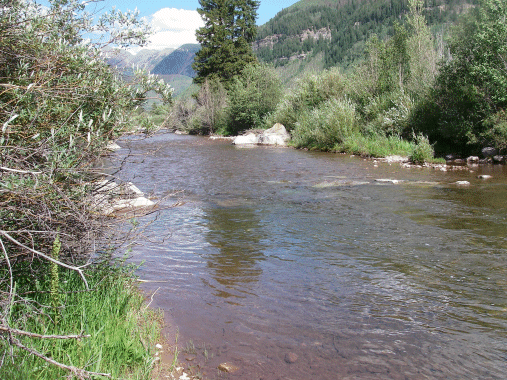
The hole shown here we've labeled as "nevermiss", and it lived up to its namesake today, giving up a half dozen trout mixed between browns and rainbows.
Just a very nice couple of hours on the water.
Tomorrow our plan is to redux the Piney River below the lake of that name. A four mile downstream hike gets us to some usually productive beaver ponds where another grand slam possibility may await.
08/03:
At the end of this day I was still trying to figure out if it had been a "half full" or just a "half empty" kind of fishing trip. We've always had pretty decent experiences on the (upper) part of the lower Piney River. Deer flies can often be an issue though we've learned to dress for that possibility and those nasty biters weren't a real problem today. The weather was decent with some cloud cover most of the day from thunderstorms that tried to form but just didn't quite make it to the level of either a lightning event or even a rainstorm.
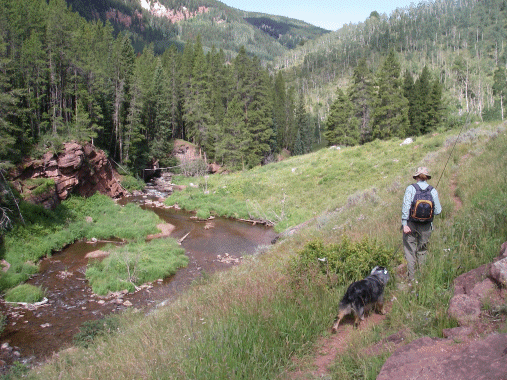
We arrived at the trailhead in late morning after the lumpy drive up Sandstone Creek, rigged up our softer rods and set off down along the creek.
Happily due to our midweek choice of a day to head down this stream, we saw not another human being all day long.
At the first beaver dammed section of meadow stream we tied on similar but slightly different dry/nymph flies.
Sue went with a surface yellow sally followed by a #16 red copper john, and I tied on a #18 gray bodied WRS and a #18 copper john.
While she worked the tailout of the dammed up pond, I went up above into the stillwater and tried my luck with some of the darn smart browns and brookies that occupy the quiet part of the stream. My success was a bit better than hers as I was getting strikes and hookups to the dry as well as the nymph.
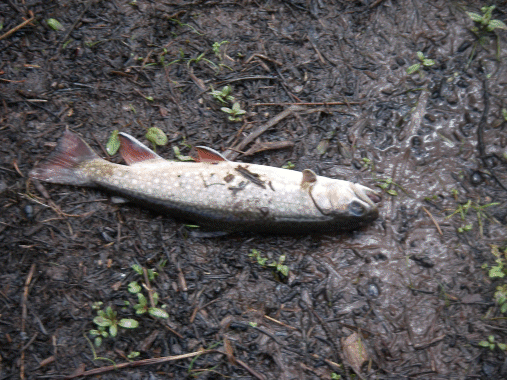
This brook trout came from the quiet water - and yes he was released unharmed back into the water.
A bit further downstream a ten inch rainbow came to hand as well so we were thinking that another grand slam might be a reasonably easy prospect today. It didn't happen though we did come close.
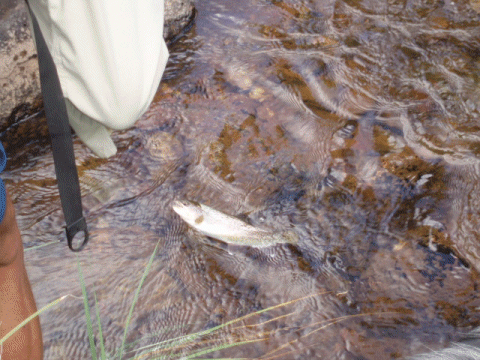
Actually we can call today's slam a "family" slam, since Sue caught all but a rainbow and I, all but a cutthroat.
Probably the most disappointing part of the trip was our very limited success in the willows just above where East Meadow Creek joins the Piney. In past years this has been the best section to fish due to more holding water and several sections of deep, undercut banks. Today all the dams had been blasted out - apparently from last winter's runoff, and the beavers have either moved on to greener pastures or simply have not begun to rebuild.
We made a number of stops on the return trip back upstream and had moderate success virtually everywhere. The fish sizes simply seemed quite small compared to previous years. All the species we hooked and released - with one exception - were in the four to ten inch range. Fun to catch but not really very exciting.
As we closed to a mile or so of our starting point, we both caught our most interesting fish of the trip.
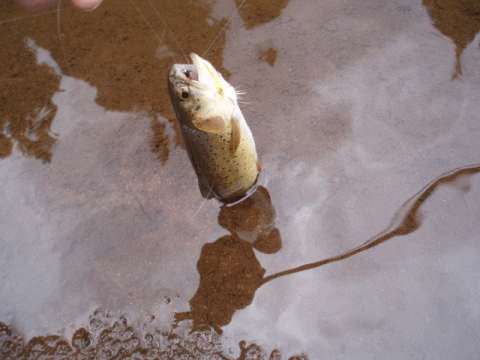
Sue released this nice Colorado cutthroat from section of stillwater that had been dammed by a fallen log.
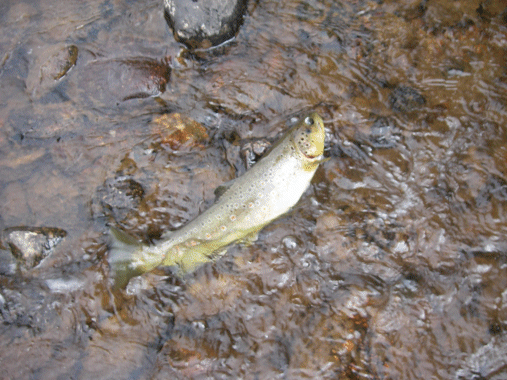
A bit further upstream, I was amazed to hook and release a very nice brown of fourteen to fifteen inches.
All the rest of the fish we played through this part of the river were quite small. So it was a trip of mixed blessings. We'll definitely come back again next year, perhaps with somewhat lowered expectations.
08/07-08:
A couple of business issues drove us to Glenwood early Monday morning - which of course was a perfect excuse to get in some casting around the Roaring Fork valley where we no longer have a dwelling unit, thus limiting the amount of time we spend there.
Recent thunderstorms, particularly last night's massive downpour in here in Vail suggested we might have some problems with water clarity in the Fork itself or more likely in some of its feeder streams that we also enjoy. That situation turned out to be the case today. Looking at the Roaring Fork on our way to Carbondale suggested that the Crystal had probably blown out overnight, and that was the situation when we drove over the Crystal's bridge just west of town.
Since the water flow web site indicated that the Frying Pan was also running at about 250 cubes from Ruedi dam releases, that stream too would not have been much fun to wade. Thus we were limited to trying some spots on the Roaring Fork even though the river was quite off color at the moment. For something different we chose to hike the water plant access area which section is occupied by other shore casters. The first nice pool we tried yielded not a hint of a strike despite its previously have been an outstanding section.
Not a good start to the day. Upstream things really didn't get better either.
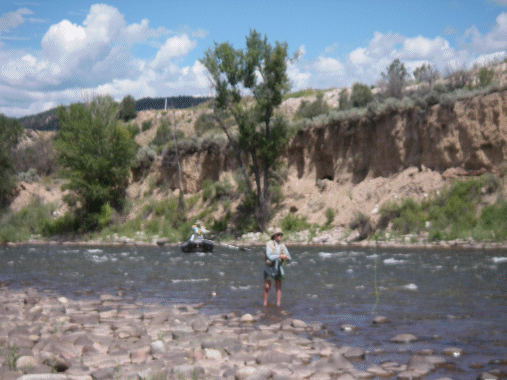
In a normally nice flat pool generally teeming with browns, I had one strike on a nymph, and Sue was shut out.
We eventually got up to some decent boulder strewn edge water and Sue picked up a couple of strikes and I landed one very nice sized brown (see photo below) that took a #18 graphic caddis I was towing behind a larger black stone. But for three hours of work, that single fish released doesn't constitute much of what we'd term "success".
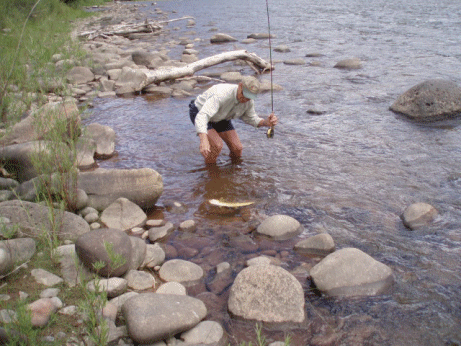
Driving back to Glenwood for lunch we then opted to try the nice bank water behind the Safeway store near the doggy park. It didn't get any better here either.
Despite our changing rigs several times from dry/nymph to nymph/nymph, we just couldn't get any strikes, much less hookups. The sun was blistering in the sky, air temperature was 91 degrees, and it just felt like the dog days of summer were upon us.
Eventually a bit further upstream we did get into a few fish in some pockets by the bank, but it truly cost us an inordinate amount of work for a minimal level of reward. I guess some days are just going to be like this.
As we had to meet some friends for dinner at 6:00 that evening, I asked Sue for one last hour on the water below the Sunlight Bridge. She did a crossword puzzle while I walked downstream a quarter mile or so on that relatively flat water. Finally happiness reigned.
With the sun starting to sag behind Red Mountain, the browns in the river moved closer to shore and they eagerly took to the #18 gray/tan bodied WRS that I pitched to them. It was an outstanding forty five minutes of casting to water we don't get to visit much any more.
Virtually every spot of micro structure held a fish, and they reacted like the WRS was a tenderloin steak. In that short period of time, I'd estimate releasing close to a dozen browns (one small rainbow), playing another half dozen fish, and missing a good two dozen more strikes. Just very nice finish to what had been a long and tiring day.
After dinner at our favorite China Garden restaurant we headed up the river and turned off at Carbondale, hopeful that the lack of rain this day would cause the Crystal to clear and give us some decent fishing tomorrow. Because the Crystal is restricted to no camping within a quarter mile of the river, there's really no easy camping anywhere, but this night we found a great spot.
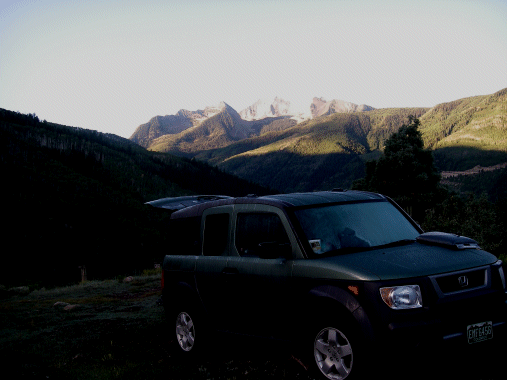
A rough dirt road leading to a trailhead just below McClure Pass led us to a wonderful bluff overlooking the river and the Raggeds. We spent the night there It would have been perfect had thunderstorms not erupted long after we'd settled down for the night.
Next morning we drove a couple miles back to Redstone, fueled up at a new restaurant - not great - and then retraced our steps back upstream to some nice looking water just before the turnoff to Marble. Fished with various rigs for an hour with one strike to show for our efforts and worried that our day again was going to be another long unproductive one.
Downstream in our happy hunting grounds in the town of Redstone things got lots better. Keep in mind these are not big fish. Once in a while we'll hook a hog of fourteen or fifteen inches, but most of the time the rainbows here run in the six to twelve inch range and that was the situation today. Happily there were lots of them. At times quantity does make up for quality.
Each of our last three stops produced at least a dozen fish to the #18 gray/tan bodied WRS. Don't know why they kept coming to the surface, but we'll not argue with success. Interestingly the Crystal is still flowing on the high side, so there should be at least another 2-3 weeks of wonderful fishing on this river.
8/10:
Interestingly today was my first venture on to another of our "home" rivers, the Eagle. A couple of decent weather days have allowed the stream to clear and settle down a bit. Happily for the quality of life for the resident fish, it's still running a bit on the high side from a flow standpoint.
After finishing up some data input work at the county offices, I headed upstream along the north bank of the river on US 6. Unhappily the first couple of regular pulloffs have now been declared private and off limits to fishing by the owner of the ranch property between highway 6 and the interstate. One of these was my favorite part of the river, so it was quite a disappointing discovery to say the least.
Upstream a couple of miles an access point was unoccupied so I rigged up with a floating RL WRS and trailed it three feet by a bead head pupa and set out on the water. Frankly the fishing stunk. I thought I was back on the Roaring Fork from earlier in the week. There were no hatches of any kind, nor were there even any caddis in the brush along the banks. It felt like the whole river had gone dead - here we go again with the dog days of summer.
Eventually I hooked and released a foot long rainbow that took the pupa on a swing and further upstream in another nice pool, I had a couple of other strikes, but even changing to a double down nymph rig didn't bring any more success.
My next stop was in the red canyon section where I waded across the river and again tried a variety of rigs in some riffle water and a large flat. Nothing doing. It got depressing. After working a good half mile of water with only one more fourteen inch brown to show for the efforts, I finally bit the bullet and rigged up with a larger white rubber legged golden colored WRS - size 14 - and did the copper/dropper approach behind it.
This rubber leg fly is as ugly as dirt, so I was counting on it to simply be a decent strike indicator. Naturally on the second cast a sixteen inch rainbow inhaled it and greyhounded all over the river. It didn't make any sense. But after another handful of fish did exactly the same thing, I was slowly becoming a believer.
Even the trailing flies eventually began getting some action which made the day something of a success. My problem with big attractors like a hopper is that I'm just so often focused on trying to match a specific hatch that I can't imagine anything wanting to eat something as ugly as a hopper or my stone. It just must be that time of year.
Next week, the dog & I may try the Mile again in Wyoming early in the week as flows have apparently been reduced, and then on Thursday, we plan a family two day trip up to the White.
08/14-15
These two days were planned to be a repeat visit to the upper Arkansas and upper South Platte Rivers that we commonly do this time of year. The first day was a real dog, but the trip happily ended with a flourish.
With Sue busy at work the dog & I headed out early Monday morning, passing around Copper Mountain, then through Leadville, and down the headwaters section of the Arkansas. We'd hoped to start casting at Hayden Meadows, but with almost a dozen cars already in both lots, it didn't make sense to deal with the "combat" fishing that would have been involved there.
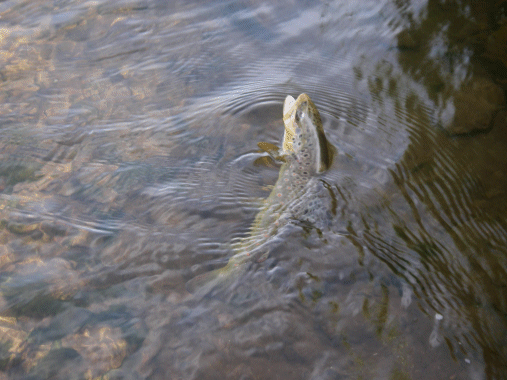 A bit further
downstream the Kobe Ranch section was only lightly occupied so we gave that
stretch a quick try.
A bit further
downstream the Kobe Ranch section was only lightly occupied so we gave that
stretch a quick try.
It was decent fishing right off the bat with a nice ten inch slob (shitty little ole brown) taking the white rubber legged WRS on the second cast. Just a bit upstream the same thing happened quickly too.
Then we ran out of decent holding water and walked a good quarter mile before picking another fish up on the trailing copper john.
Two or three more small browns later we gave up the chase here, got back in the car and headed to a favorite spot near Granite.
Although this section sometimes yields good sized browns, today was a bust. I had a couple of decent strikes but came up completely empty handed from a hookup standpoint. Ugh.
Lunch at our burger joint in Buena Vista cheered me, after which we headed up Trout Creek Pass and stopped at another favorite place near Hartsel. The water color is really an unpleasant puce green in this part of the Platte, I'd guess due to very small releases from Antero this year. Happily though, it sounds like that once productive impoundment is going to reopen in 2007.
The fishing was very decent in this water. A smaller #18 dark colored rubber leg WRS trailed by a red copper john took lots of fish even with very mossy conditions present. On the flip side, the browns here are very small - none were over ten inches and most were in the five-six inch range. Not a lot of fun playing fish of that size.
With the afternoon wearing on we made one more stop at an access point a couple of miles above Spinney Reservoir. It was a long hike to the stream there, and unhappily the fishing again stunk (or I did). In an hour or so of walking and casting a variety of flies, my only score was one eight inch rainbow.
Down past the Spinney tailwater parking areas we drove, had a short happy hour of gorgonzola & crackers (plus some nice carignane wine) and set off to try the lowest part of the tailwater near Elevenmile Reservoir. Another losing cause. Completely shut out there. Should have tried it further upstream but I dislike fishing around the other people who were still cramming the upper lots.
Had a quick dinner and decided to pass on camping near and then fishing that tailwater the next morning. As we'd never ventured up and over Weston Pass, and since there apparently is fishing on both sides of that divide, we headed up that way. It got dark a lot quicker than we'd anticipated and we ended up camping near the summit that night. At almost 12,000 feet of unmaintained rocky road, the drive up was not a lot of fun - and worse was yet to come the following morning.
The drive downhill from the pass was very difficult to say the least. Our Honda Element has decent quasi four wheel drive, but somewhat limited ground clearance. Low gear for several miles on the West bound descent was the rule and miraculously we didn't scrape the frame although I'm sure we came close numbers of times. I doubt very much I'd even attempt ascending this road from the West side. At least now we know.
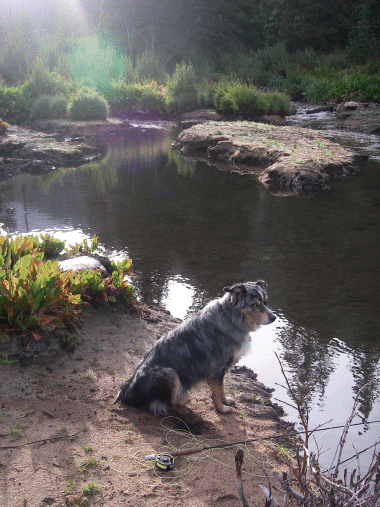
The small stream on the downhill side of the pass grew in size fairly rapidly. It's primarily a string of unrelenting beaver dammed ponds, and frankly, I don't enjoy that type of fishing, but eventually we came to a spot where a dam had burst and the creek was more visible. See photo.
It was full of tiny brookies that seem to populate all of our high mountain valley waters. I could catch them relentlessly without even moving my feet, several times having double hookups.

As with most of these situations, too much of a good thing is not a good thing, so we left the area fairly quickly continuing on past the private Mt. Massive Lakes development and back down to the Arkansas.
Eventually along that stream we made a very interesting discovery. There's a stretch of the Arkansas whose access point is far less than transparent to the casual observer. Fortuitously we found it today.
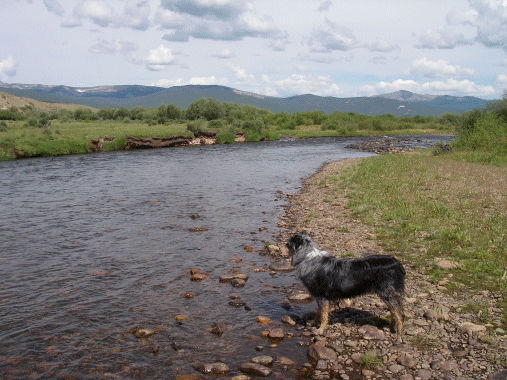
Very interestingly this part of the stream has a split personality. The first section we fished flowed too quickly, had limited holding water, and where fish could hold, it was very deep and difficult to access, and there seemed to be few numbers of fish.
The second part was wonderful. Better gradient. Far nicer holding water in runs, pools, and beside undercut banks, and it held very nice numbers of fish.
In the former section I could only get strikes on heavily weighted streamers. In the latter, a #16 black rubber legged WRS took all kinds of fish. It was outstanding and lots of fun.
OK. Here's a contest. If anyone reading this account thinks they know what water I'm describing, send me an e-mail, and if you're right, I'll send you the fly that worked here today in a return envelope.
Enough. Tomorrow the family heads to our "favorite" river for a couple days of casting there. Then this weekend Sue's off to help with guiding some others of her gender at the Coryell Ranch near Glenwood. The dog & I might go along and try the Fork while she's tied up on the ponds.
08/16-17:
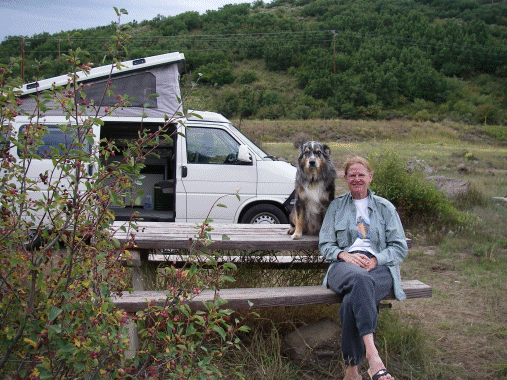
We took the Eurovan on a rare overnight excursion for "it" this year.
So much of our tripping has been on difficult back country roads that the Element has gradually become our "troutmobile" of choice.
Arrived at our favorite stretch of our favorite stream just after the noon hour and were pleased to note that as is almost always the case, there were no other fishers about. Happiness is lots of water to one's self. The river is still running at a remarkably decent rate for this later part of the summer. Don't know why it's the case as this part of the state supposedly did not receive an excessively unusual depth of snow last winter, but we're pleased for the health of the river and its inhabitants.
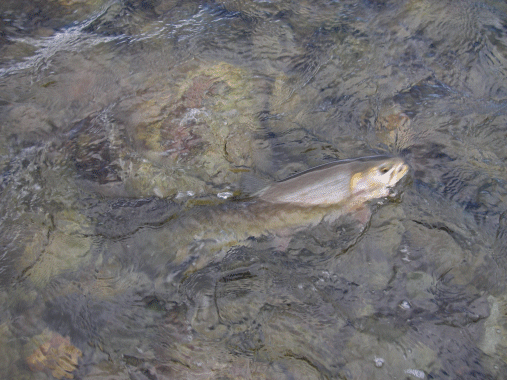
Did our regular walk from upstream down along river left and started out in the first good water with a couple of nice rainbows and cutthroats.
It sounds unusual to fish downstream, rather than up, and we actually don't do that - unless streamers are called for. Rather we simply hike down along the river for roughly a mile and then begin the trek back to our starting point casting along the way.
Fly selection was something of a problem. Fishing reports suggested that the hopper-copper-dropper approach was favored this time of year, and we worked our way around that issue, sometimes for the better, sometimes for worse results. The first day Sue experimented with a variety of dries - hopper, standard WRS, and black rubber leg WRS. I opted for a black RL WRS to open with, and we used a lot of different nymphs as trailers.
Much to our surprise, all the nymphs we attached were quite ineffective with probably 95% of the strikes coming to a dry fly. Hatches were pretty much nonexistent with not even any midges showing in the eddies. A few small caddis flitted around in late afternoon, but the late summer conditions that seem to exist now everywhere in the state prevailed here as well.
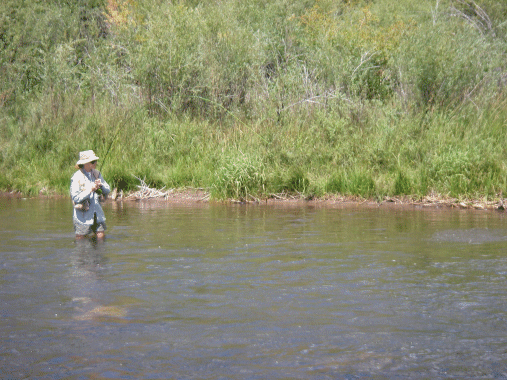
It's also worth noting that hookups with whiteys were very rare. Suspect we released less than a half dozen of them in the two days we spent on the water. Somewhat unusual given the relatively large quantities of that fish occupying this stream.
Cutthroats happily continue to make up a good portion of the catch here. Much greater populations of them - and in better sizes this year than I've ever seen on the river before.
At some point early in our wade upstream, I swapped the leading dry fly for a really butt ugly one that had worked well on the Arkansas the prior week.
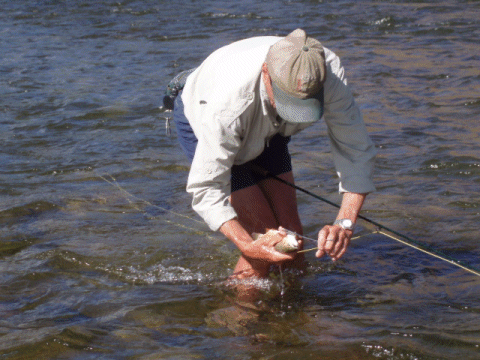
It's a somewhat large (probably size 14) golden salmon fly colored WRS with white rubber legs, and in all honesty, it really is very unattractive to my eyes.
Apparently the fish didn't share the same visually negative sense I have about that specific fly and frankly, rubber legs in general.
It produced extremely well the first day and the second. Given the absence of stonefly husks along the banks and with virtually no hoppers in the streamside grasses either, I simply don't know why the fish fell in love with it - but they did. Rainbows and cuts from six to twenty two inches inhaled the fly.
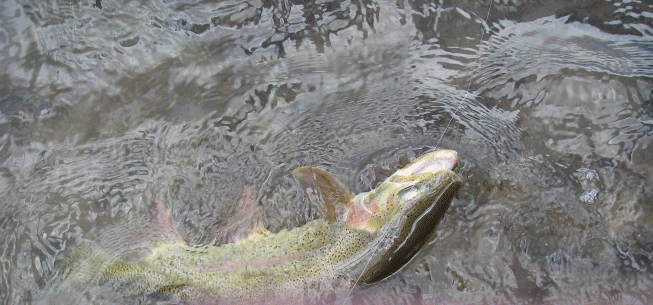
This big rainbow took a good ten minutes to land and release and easily weighed 4-5 pounds.
Just a monster male with a mouth so large, I could place my fist in it.
The afternoon was a good one.

Sue played and released a wonderful sixteen inch cut and I had several other releases in the 14-18 inch range - mostly rainbows with a sprinkling of the former species.
We gave up the water a bit early as five straight hours of wade casting is a good bit of work for anyone. Headed to our nicest (free) public campground and as usual found it completely devoid of other vehicles. Life's good!
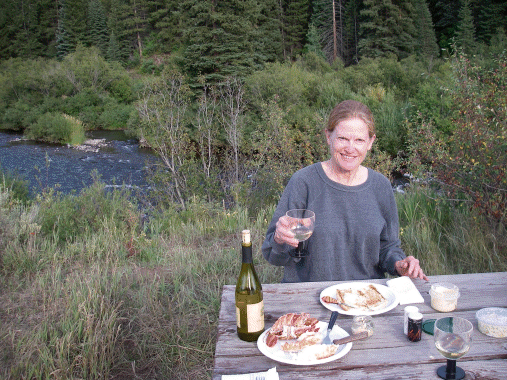
Dinner was also good due to the summer's second incarnation of the lobster roll feast we enjoyed last month down near the Gunnison.
Obviously a delicious Chardonnay didn't hurt the evening either.
This morning we'd hoped to try a short stretch of rather obtuse USFS water up the river a few miles, but when we arrived at the only parking pulloff, it was overrun with some construction crews doing road work. We elected to avoid fighting that problem, turned around, headed back downstream, and drove to one of the "catch & eat" sections that used to be quite good.
Today it was not. A handful of mixed cuts and rainbows for an hour of casting doesn't count as good results.
Back to our normal water we drove, parking at the downstream entrance and we began our upward walk. First couple of sections provided indifferent results. Lots of passing clouds made seeing the surface fly almost impossible in places and missed strikes were the order of the day.
Eventually we got back to the trough hole and life improved. I hooked and released a sixteen inch cut, then an eighteen inch bow fairly quickly.
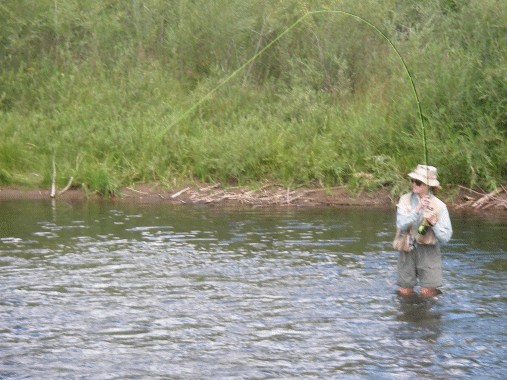
Sue finally tied on the same white rubber legged WRS - the last one in the box - and on her second cast with it, played for another ten minutes, another great sized rainbow.
It flipped off the fly as she was bending to release it, but we both estimated it in that husky twenty - twenty two inch range. Wonderful fish and terrific fishing one more time on our most loved stream.
8/22: In the hopes of getting in a bit of local stream casting before the day's thunderstorms erupted, the dog & I headed to Wolcott and then to State Bridge to try our periodic hike up the Colorado to a favorite braid that always holds decent browns. Unfortunately the river was running quite high - not enough to discourage the fish from biting - but too high to make the streamside wade just up river from the Piney's mouth approachable. The alternative to walking up the shore is a long climb up the adjoining bluff, and quite honestly, I was just too lazy to deal with it today.

Here's the dog patiently waiting for me to snap this shot of the Piney. In the picture the river appears quite a bit larger than it actually was. The reality is that it can be easily waded anywhere and really is very shallow for the most part.
We ventured carefully up the lower part of the Piney. Before entering that canyon we did release a handful of the smallish local browns from some pocket water on the Colorado.
Fish took either a white rubber legged golden stone colored WRS (boy, that's a mouthful) - or the trailing green copper john.
There actually was a very vibrant trico hatch in progress on the Colorado as well as a couple hundred yards up the Piney.
The Piney itself is at very low summer flow right now - probably , and I suspect many of the better fish that enter this stream during their respective spawning seasons have long since returned to the Colorado. Probably 15-25 cubes at best moving through this part of the river.
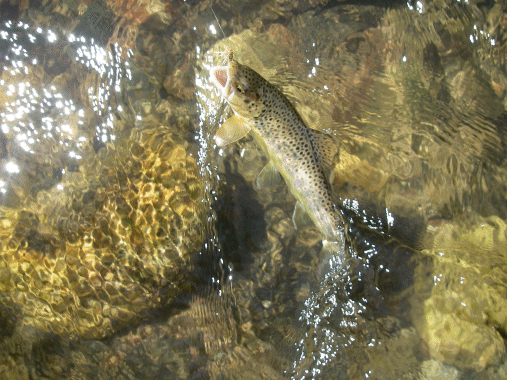
Frankly I found the fishing very spotty. Because of the shallowness of the water and limited holding areas, I tied on a much smaller rubber leg WRS. Trailed it with a variety of nymphs before finally giving up on that idea. Simply couldn't get anything interested in the sunken flies.
From time to time a small brown or rainbow would inhale the hopper looking WRS. Browns ranged from six to ten inches with the rainbows a bit larger running from eight to twelve. Last fish of the day was a much nicer fourteen inch bow that came up from a deeper hole under the lone bridge crossing of the jeep road that follows along the stream.
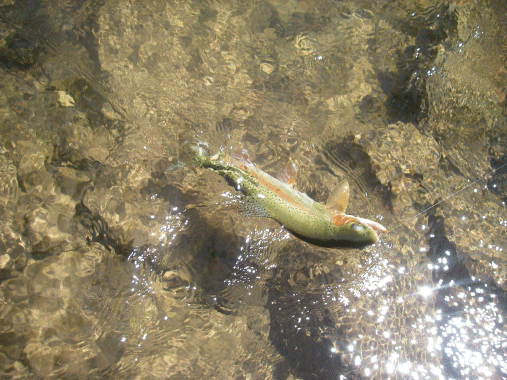
The rainbows are very beautiful fish here. Much more brightly colored than I've seen elsewhere (despite this somewhat nondescript photo of one of them).
Thursday we're off on another cutthroat gathering excursion to Western Wyoming. We should catch bunches of Snake River fine spotted, a few Bonneville, and hopefully with two full days of time to spend on some of the tough beaver ponds up the Cottonwood and Horse Creek drainages - finally land a Colorado cut or two.
Last Logbook Entry � for previous days
8/24-29: Wow. It was a long trip. Happily it ended successfully but not without a number of belches and bumps along the way. This year's jaunt to western Wyoming could best be described as a last gasp attempt to finish off the classic "Cut Slam" offered by that state's Game and Fish Department. When we first began this quest, it seemed like it should be a simple problem to solve, given the well structured definitions of where the various cutthroat species were based through different watersheds. Unfortunately simply knowing where fish should be does not mean they will necessarily be there - or be easily accessible.
Back in July of 2002, we started searching for the different cutthroat strains that were originally native to the state. That first year we thought we'd gotten within one of the final total - just missing out on a Colorado cut. - a species we encounter all the time here in our home state. As it turned out, we probably also had not yet landed one of the more rare Bonneville types, even though Sue thought she'd photographed a couple of them in the upper reaches of the Smith Fork of the Bear River.
Two intervening years of searching for the Colorado produced nothing but frustration. This summer we finally reached our goal - and it truly is very satisfying.
Let's recap how the trip proceeded.
We'd allotted 6-8 days for travel and fishing. To keep from having to do a minimum of a nine hour drive right out of the box, we left Vail early Thursday morning, drove to Rifle, then north to Craig, and left on Highway 40 to Maybell. Taking the back road to the lower part of the Green River tailwater, we arrived at the Jarvie Ranch part of "B" section in early afternoon.
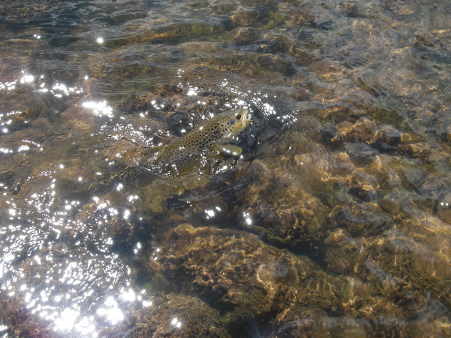
There's some very inviting brown trout water below that area's local campgrounds, so we rigged up and began casting for what we hoped would be somewhat fewer, but simultaneously larger browns. The last time we came through here with lousy weather conditions the fishing was quite outstanding. Today it stunk.
Early in the process I landed a thick bodied sixteen inch female that inhaled the #16 white rubber legged WRS.
That fish turned out to be our only success of the afternoon despite our casting to what looked like outstanding riffle water.
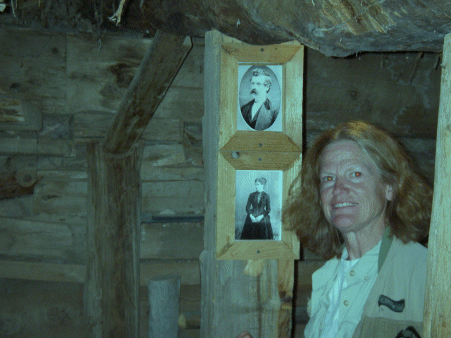
While we'd planned to camp near Jarvie or down by Bridgeport, after doing a bit of exploring of the interesting historic ranch site - yes, another of Butch Cassidy's hangouts (Sue hopped in his bed in the dugout where he hid from time to time) - we decided to get closer to our Wyoming destination that night.
We drove up the dirt road back to Highway 191, turned left and made our way down the Spring Creek access road to Flaming Gorge Reservoir. Found a nice camping site, had a decent meal, and spent a quiet night by the lake. Happily no rattlers came to call for a change.
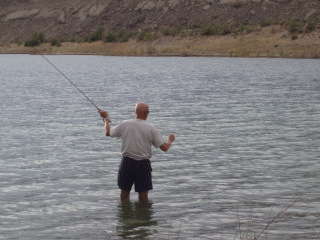
I cast for smallmouths off the shore and released a couple of small ones before bedding down for the evening.
Next day it was up and at 'em. It was another five hour drive to our first cutthroat casting spot on the upper Smith Fork. We stopped at the first piece of public water, and miraculously - for my perspective at least - both landed and released some nice Bonneville cuts.
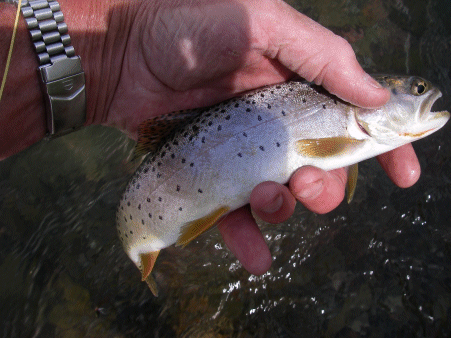
The water was also rife with local whitefish which took the nymph trailing our fake hopper imitations. A few rainbows also came to hand, though none of any of these fish exceeded fourteen inches. All in all, it was an auspicious beginning to our week.
Heading up the Dry Fork, we turned off and fished the Smith above where it intersected with Hobble Creek. Two other vehicles were set up on the latter stream so we chose not to compete with those anglers and instead waded upstream on the smaller Smith Fork casting flies to what turned out to be hordes of tiny rainbows.
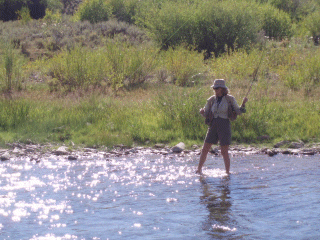
There's too little flow on this part of the creek, and the fish are also too small and way too numerous. Sue enjoyed it more than I did, as she perfected her "strike ratio". In all honesty I can't stand that type of fishing, but we persisted for an hour or so.
In early evening we continued on up Dry Fork, passed through the Tri Basin Divide, down Labarge Creek for a bit, around Poison Meadows, and over the pass heading down the Grays River - a stream we'd not yet visited. The sign at the top of the Grays reads "Watch Me Grow". That's no understatement. An unusual number of strong feeder streams fill the Grays very quickly. I suspect many of these creeks are probably wonderful fishing too - if one has the time to do the exploration.
We camped high on the river. Thunderstorms persisted during dinner and through the night. It was cold and gloomy when we awoke the next morning and barely had broken camp when the rains began in earnest. After a few miles of unrelenting downpours, I thought I was back in Oregon. It was really ugly outside the car. There was no possibility of pulling off the road, rigging up, and trying to make some casts. Just awful weather. Every time we'd come around a corner where it looked like a great fishing spot, I'd curse mother nature again and again.
There simply was no way to do any fishing. I'd never seen weather like this in our part of the Rocky Mountains. Frustration reigned. With no possibility of casting, we kept on driving. All the way down the river to Alpine. Then to Jackson. Then to Teton National Park. Eventually in mid afternoon the rain relented a bit, at which point we were able to leave the highway at the Schwaybacher Landing area. The last time we were here the braids were full and we had decent success with nice sized Snake River cuts right next to the parking area. Today the river was much lower, and the braids were devoid of trout.

With nowhere else to go for the moment we eventually hiked all the way to the main river and found fairly good fishing right along the bank. Anywhere there was the slightest bit of structure or holding water, there were trout. It was fun.
Both of us missed a number of better sized fish, but we both connected on some nice finespotted cuts to twelve inches. Again the golden stone colored WRS with either white or green rubber legs in size sixteen was the preferred fly.
Having pretty much preprogrammed our few Wyoming days this year to concentrate more on the Colorado strain fish, we had to leave any thought of returning to the Gray or going up the Gros Ventre behind and begin our loop up the Hoback to the Green River drainage. Historically we've very much enjoyed spending time on the Hoback.
The lower river has offered plenty of easy access and good fishing for finespotted trout smaller in size than on the Snake but greater in quantity. Unfortunately today was a bust in that regard. The rainstorm that drove us off the Grays had discolored this river too.
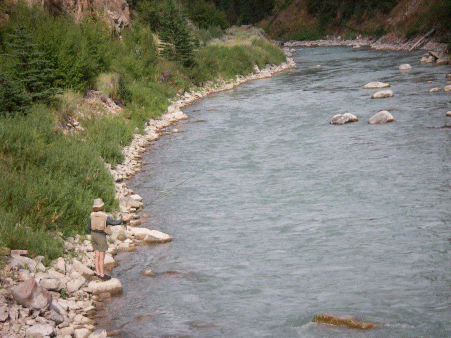
Our primary fishing stop brought nothing but some whitefish as nothing but deep nymphing would produce a strike.
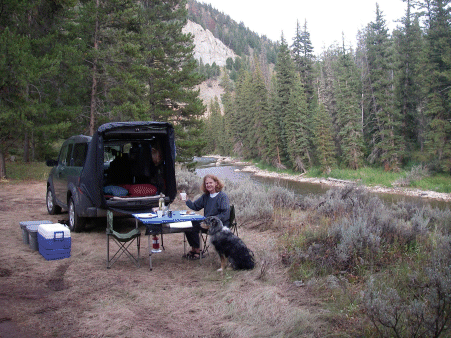
Even upstream where the water had cleared substantially beside our camping place, the fishing was a bust.
Next morning we drove up & over the pass, turning off 191 to grab breakfast at Pinedale, following which we continued on south to Big Piney, where we headed up the middle fork of that stream. Stopped just inside the Forest Service boundary and caught a number of small brookies in a quiet meadow.
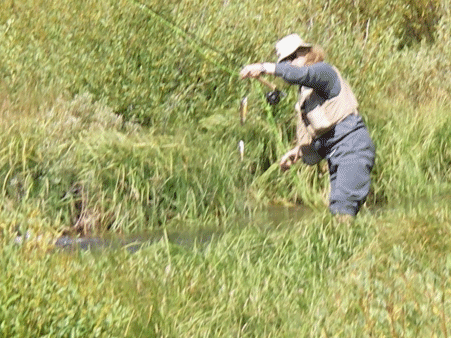
Sue even had a double of these aggressive little fish.
Assuming the whole stream was probably nothing more than a brook trout haven, we then drove all the way to Middle Piney Lake.
A nice sized body of water created by a terminal moraine, we started fishing with hopper shaped WRS's trailed by a variety of nymphs.
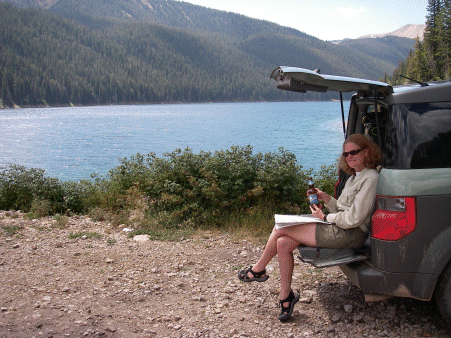
Eventually both of us caught some of the modest sized stocker rainbows and I was sick to have missed a strike from what would have been a very nice Colorado cut. Shifting to streamers brought a bit more success, but only on the rainbows.
Headed back downstream and stopped again at at willow clogged meadow part of the same stream just below its confluence with Straight Creek. Here, while we could still only find brook trout, the sizes were much better - to ten inches easily - and the fishing for that species was really wonderful.
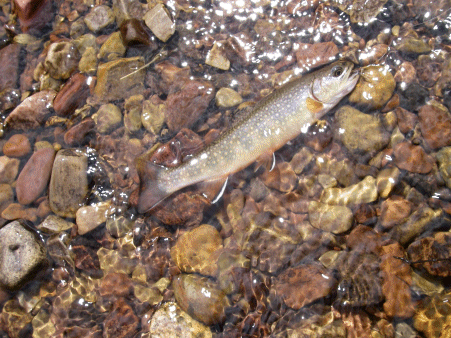
Every few feet of wading brought several strikes. Just an outstanding brookie fishery - if that's what one is seeking.
Drove along forest road 10046 to get to the North Piney which we tried for a while and again, could only land brook trout. Further on that road we arrived at "The Cottonwoods", the upper section of that creek system, and here we found success.
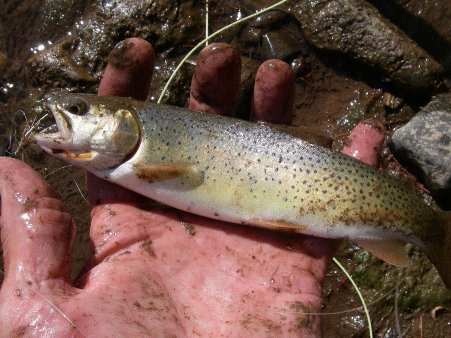
Because a portion of this fishery is so transparently easy to work, we'll not completely disclose the precise location we fished and were able to photograph our last cutthroat strain, the Colorado.
It was a real joy to finally have completed the slam, and we stayed long enough to release several of these wonderful fish.
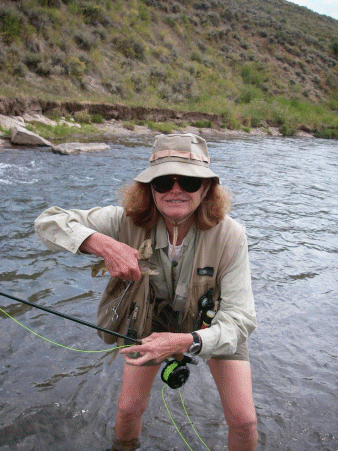
With an extra day to kill now, we looked at the local topo map and found a way over the divide between this basin and the Grays and drove over McDougal Gap late in the afternoon, down Sheep Creek, and camped for the night again on the Grays.
We were very excited to actually have a second shot at that interesting stream. As it turned out, my comment on the fishing is a takeoff on the old adage "Be careful what you wish for.............."
While I fairly quickly caught a nice finespotted the next morning, this river system turned out to be perhaps the most disappointing of the trip. Cuts - at least those on most of the streams we visited - simply don't enjoy the same type of holding water as do rainbows or browns. They seem to need much deeper holding areas, and on the Grays, there didn't seem to be many of those. Consequently we didn't run into nearly as many fish as we would have thought to.
In all honesty, if a person had plenty of time to do some major exploring away from the road that parallels the river, there probably would be lots of good fishing spots to be found. We simply didn't have the time to hike through the ever present willows and were forced to fish some of the more accessible spots, which again are more heavily pounded by the local fisher people.
OK. We hit the town of Alpine Junction later in the day and since we basically had completed our mission, decided to begin the drive back home.

With one last night to camp out in the state, we chose to return to the Smith Fork one last time and get in some final casts, which we did.
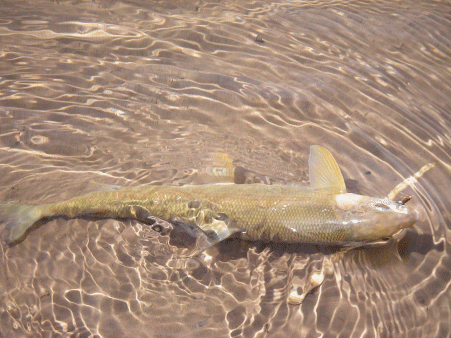
The little stream was still productive although in different ways for each of us. Sue did the dry/nymph rig thing and landed nothing but whitefish that took the dropper, while I stuck with two dries and released nothing but Bonneville's. So it was a nice conclusion to a long trip and a time consuming, but very enjoyable quest.
The Cut Slam
Just a quick retrospective on this project. As noted, it took us what seemed like forever to complete the catching and photographing of all four cutthroat strains. We wandered all over western Wyoming, but as it turns out, we probably now know many of these streams better than even the locals do. In saying that I suspect that with the knowledge we now have, we could probably complete the slam in a maximum of two to three days as opposed to the four or five weeks spread out over four years that it actually took to achieve success.
In terms of difficulty of fish to obtain, the Colorado and the Bonneville were neck and neck. The Snake River and Yellowstone are clearly the easiest. In coming years the Colorado should be much easier to acquire given the Fish and Game Department's ongoing poisoning and what will be a subsequent restocking of Labarge Creek. At that point the Bonneville will probably be tougher, and I would guess Hobble Creek or Lake Alice might be the best source for that fish.
We both really have learned to love cutthroats. Each of the strains are beautifully colored and enjoyable to catch. It's almost sad this part of the journey is over for us, but I'm sure we'll go back again to seek them out more times in the future.
Home, Main Fishing Page, , Eagle River Access, Local Ten Commandments, Successful Fly Patterns